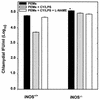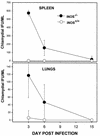Chlamydial infection in inducible nitric oxide synthase knockout mice
- PMID: 9529043
- PMCID: PMC108050
- DOI: 10.1128/IAI.66.4.1282-1286.1998
Chlamydial infection in inducible nitric oxide synthase knockout mice
Abstract
Type 1 CD4+-T-cell-mediated immunity is crucial for the resolution of chlamydial infection of the murine female genital tract. Previous studies demonstrating a correlation between CD4+-T-cell-mediated inhibition of chlamydial growth and gamma interferon (IFN-gamma)-mediated induction of nitric oxide synthase suggested a potential role for the nitric oxide (NO) effector pathway in the clearance of Chlamydia from genital epithelial cells by the immune system. To clarify the role of this pathway, the growth levels of Chlamydia trachomatis organisms in normal (iNOS+/+) mice and in genetically engineered mice lacking the inducible nitric oxide synthase (iNOS) gene (iNOS-/- mice) were compared. There was no significant difference in the course of genital chlamydial infections in iNOS+/+ and iNOS-/- mice as determined by recovery of Chlamydia organisms shed from genital epithelial cells. Dissemination of Chlamydia to the spleen and lungs occurred to a greater extent in iNOS-/- than in iNOS+/+ mice, which correlated with a marginal increase in the susceptibility of macrophages from iNOS-/- mice to chlamydial infection in vitro. However, infections were rapidly cleared from all affected tissues, with no clinical signs of disease. The finding of minimal dissemination in iNOS-/- mice suggested that activation of the iNOS effector pathway was not the primary target of IFN-gamma during CD4+-T-cell-mediated control of chlamydial growth in macrophages because previous reports demonstrated extensive and often fatal dissemination of Chlamydia in mice lacking IFN-gamma. In summary, these results indicate that the iNOS effector pathway is not required for elimination of Chlamydia from epithelial cells lining the female genital tract of mice although it may contribute to the control of dissemination of C. trachomatis by infected macrophages.
Figures


Similar articles
-
Inducible nitric oxide synthase does not affect resolution of murine chlamydial genital tract infections or eradication of chlamydiae in primary murine cell culture.Infect Immun. 1998 Feb;66(2):835-8. doi: 10.1128/IAI.66.2.835-838.1998. Infect Immun. 1998. PMID: 9453651 Free PMC article.
-
Chlamydia trachomatis persistence in the female mouse genital tract: inducible nitric oxide synthase and infection outcome.Infect Immun. 2001 Aug;69(8):5131-7. doi: 10.1128/IAI.69.8.5131-5137.2001. Infect Immun. 2001. PMID: 11447195 Free PMC article.
-
Genital tract infection with Chlamydia trachomatis fails to induce protective immunity in gamma interferon receptor-deficient mice despite a strong local immunoglobulin A response.Infect Immun. 1997 Mar;65(3):1032-44. doi: 10.1128/IAI.65.3.1032-1044.1997. Infect Immun. 1997. PMID: 9038313 Free PMC article.
-
The role of IFN-gamma in the outcome of chlamydial infection.Curr Opin Immunol. 2002 Aug;14(4):444-51. doi: 10.1016/s0952-7915(02)00361-8. Curr Opin Immunol. 2002. PMID: 12088678 Review.
-
Duration of untreated chlamydial genital infection and factors associated with clearance: review of animal studies.J Infect Dis. 2010 Jun 15;201 Suppl 2:S96-103. doi: 10.1086/652393. J Infect Dis. 2010. PMID: 20470047 Review.
Cited by
-
Toll-like receptor-induced arginase 1 in macrophages thwarts effective immunity against intracellular pathogens.Nat Immunol. 2008 Dec;9(12):1399-406. doi: 10.1038/ni.1671. Epub 2008 Nov 2. Nat Immunol. 2008. PMID: 18978793 Free PMC article.
-
Restriction and evasion: a review of IFNγ-mediated cell-autonomous defense pathways during genital Chlamydia infection.Pathog Dis. 2024 Feb 7;82:ftae019. doi: 10.1093/femspd/ftae019. Pathog Dis. 2024. PMID: 39210512 Free PMC article. Review.
-
The intercellular adhesion molecule type-1 is required for rapid activation of T helper type 1 lymphocytes that control early acute phase of genital chlamydial infection in mice.Immunology. 1999 Dec;98(4):510-9. doi: 10.1046/j.1365-2567.1999.00926.x. Immunology. 1999. PMID: 10594682 Free PMC article.
-
Fate of Mycobacterium tuberculosis within murine dendritic cells.Infect Immun. 2001 Feb;69(2):800-9. doi: 10.1128/IAI.69.2.800-809.2001. Infect Immun. 2001. PMID: 11159971 Free PMC article.
-
Plac8-dependent and inducible NO synthase-dependent mechanisms clear Chlamydia muridarum infections from the genital tract.J Immunol. 2012 Feb 15;188(4):1896-904. doi: 10.4049/jimmunol.1102764. Epub 2012 Jan 11. J Immunol. 2012. PMID: 22238459 Free PMC article.
References
-
- Adams L B, Hibbs J B, Taintor R R, Krahenbuhl J L. Microbiostatic effect of murine-activated macrophages for Toxoplasma gondii: role of synthesis of inorganic nitrogen oxides from l-arginine. J Immunol. 1990;144:2725–2729. - PubMed
-
- Boehm U, Klamp T, Groot M, Howard J C. Cellular responses to interferon-gamma. Annu Rev Immunol. 1997;15:749–795. - PubMed
Publication types
MeSH terms
Substances
Grants and funding
LinkOut - more resources
Full Text Sources
Other Literature Sources
Medical
Research Materials

